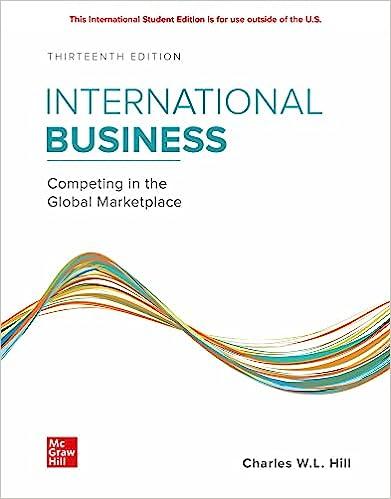Best Buy Co., Inc. is an American multinational consumer electronics retailer headquartered in Richfield, Minnesota. The company
Question:
Best Buy Co., Inc. is an American multinational consumer electronics retailer headquartered in Richfield, Minnesota. The company was founded by Richard Schulze and James Wheeler in 1966 as an audio specialty store called Sound of Music. In 1983, Sound of Music was rebranded to Best Buy after having achieved $10 million in sales in its seven stores to place more emphasis on consumer electronics. From 1983 to about 2012, Best Buy was an American success story, achieving $1 billion in sales in 1992 in a short period of time and entering its first international location in Canada in 2001 by acquiring Future Shop Ltd. More sales followed after entries into China, Puerto Rico, United Kingdom, Mexico, and Turkey.
In this period (2001 to 2009), Best Buy was named “Company of the Year” by Forbes magazine in 2004, “Specialty Retailer of the Decade” by Discount Store News in 2001, ranked in the Top 10 of “America’s Most Generous Corporations” by Forbes in 2005, and made Fortune magazine’s list of “Most Admired Companies” in 2006. The retail model that Best Buy had created seemed to be on the upswing, and customers flocked to the stores to check out new gadgets and purchase products. Then, Best Buy’s expansion, business model, and interest among customers declined in just a few years.

As a result, Best Buy closed its operations in the United Kingdom, China, and Europe between 2010 and 2012, and appointed Hubert Joly as its CEO in September 2012. Best Buy had annual revenues of about $29 billion in 2012, but Joly turned around the company in such a way that its 2013 saw $45 billion in revenue, an amazing increase of 55 percent in just one year. Joly did this, in part, by quickly issuing a five-point manifesto to revamp the Best Buy brand, known as “Renew Blue.”
Reinvigorate the customer experience Attract “transformational leaders” and energize employees Work with vendors to innovate and drive value Increase the company’s ROIC by growing revenue and efficiency Make the world a better place through recycling efforts and giving people access to technology In addition to immediately selling its European stores, Joly trimmed staff and promised to revive sales by using “omnichannel” retailing. The simple but powerful idea in omnichannel is to reach customers wherever they are—in a store, online, or via their smartphones—and use technology to turn costly stores into an advantage. For example, Joly added a “Store Pickup” button to Best Buy’s online shop because many shoppers like to browse and pay online, but prefer to pick their consumer electronics in person. They just had no way of doing that before. The omnichannel became the turnaround strategy for Best Buy in 2012–2013.
Fast forward to 2018, and Best Buy has just closed 250 brick-and-mortar stores in the United States. These days, the international exposure of Best Buy is only in Canada and Mexico; all other international engagements have been divested or closed. At the peak, Best Buy’s international operations accounted for about 17 percent of its revenues. So, while companies such as Walmart see their international operations as a key growth driver, especially in emerging markets, Best Buy strategically decided to concentrate on only the North America region for now (Canada, Mexico, and the United States).
With these measures in place, after declining revenues for several years, Best Buy saw an upswing in 2018 that the company hopes will continue. Also, Best Buy was ranked as “The Most Sustainable Company in the United States” by Barron’s in 2019. In addition, the company ranked among the Top 100 in the Fortune 500 list of the largest corporations in the United States by total revenue. Some of it has to do with the omnichannel carryover effect carrying over from when the 2012 turnaround measures were implemented. One idea was even to use its existing store infrastructure as distribution centers, in addition to being retail stores.
Questions
1. Best Buy has had an interesting evolution in an industry (technology and consumer electronics) that has seen drastic changes in the last few decades. Based on this case writeup, how do you expect Best Buy to perform in the next 10 years?
2. The omnichannel approach that Best Buy implemented in 2012 proved to be a winner at the time, and is something all companies these days have to be mindful of. The goal is to reach customers wherever they are: in a store, online, or via their smartphones. Given the omnichannel environment we live in, how would you market Best Buy in the future?
3. In the process of switching CEOs from Hubert Joly to Corie Barry, Joly said that “Stores are a great asset.” Joly also said that Best Buy is “well positioned for continued growth well into the future.” Do you agree or not? Why?
4. As a starting point before she even took over as CEO, Corie Barry stated that “Today’s technology and consumer landscape creates tremendous opportunities for Best Buy to further expand and deepen relationships with our customers and employees, while continuing to deliver shareholder value.” What do you read into this statement, and her thinking about what Best Buy needs to do to be successful?
Step by Step Answer:

ISE International Business Competing In The Global Marketplace
ISBN: 9781260575866
13th International Edition
Authors: Charles Hill





